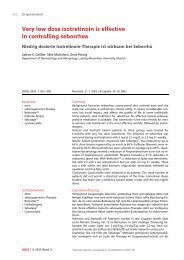Clinical Study Report - Calidad de Información CFR
Clinical Study Report - Calidad de Información CFR
Clinical Study Report - Calidad de Información CFR
Create successful ePaper yourself
Turn your PDF publications into a flip-book with our unique Google optimized e-Paper software.
Case A1. PP population<br />
If nine or fewer patients among seventy six subjects treated with Clotinab experience MACE,<br />
then the MACE onset rate is estimated to be below 20% and Clotinab is consi<strong>de</strong>red to be<br />
effective..<br />
Case A2. ITT population<br />
If ten or fewer patients among eighty four subjects treated with Clotinab experience MACE,<br />
then the MACE onset rate is estimated to be below 20% and Clotinab is consi<strong>de</strong>red to be<br />
effective<br />
Case A3. FAS population<br />
If ten or fewer patients among eighty three subjects treated with Clotinab experience MACE,<br />
then the MACE onset rate is estimated to be below 20% and Clotinab is consi<strong>de</strong>red to be<br />
effective.<br />
Case B<br />
If the number of MACE patients is over the <strong>de</strong>fined number in each population, efficacy of<br />
Clotinab is evaluated after adjusting the critical value based on the MACE onset rate in ReoPro ® .<br />
Secondary efficacy endpoint and analysis<br />
(1) Endpoint<br />
New change in electrocardiogram that indicates the status of ischemia.<br />
(2) Analysis methods<br />
Frequency, proportion and 95% exact C.I. of new changes from pre-administration to postadministration<br />
in electrocardiogram (yes/no) were presented. Fisher’s exact test was performed<br />
to find the differences between two groups. Frequency was presented and McNemar’s test was<br />
applied to <strong>de</strong>termine if the changes in electrocardiogram from pre- to post-administration is<br />
significant.<br />
9.7.1.4. Safety endpoint and analysis<br />
Safety endpoints<br />
(1) Bleeding<br />
According to the TIMI criteria, bleeding is categorized into ‘major bleeding’, ‘minor bleeding’,<br />
or ‘insignificant bleeding’. To measure the quantity of bleeding, the quantity of change in<br />
hemoglobin and hematocrit was adjusted according to whole blood and concentrated red<br />
CSR_Clotinab_II 38<br />
Ver. 1.0_Eng



